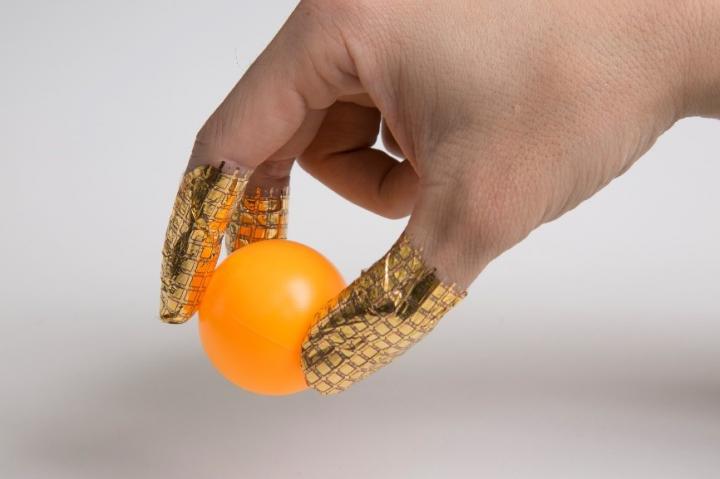A flexible, transparent pressure sensor
January 26, 2016

Pressure sensors wrap around and conform to the shape of the fingers while still accurately measuring pressure distribution. (credit: 2016 Someya Laboratory)
Doctors may one day be able to physically screen for breast cancer using pressure-sensitive rubber gloves to detect tumors, thanks to a transparent, bendable, and sensitive pressure sensor newly developed by Japanese and American teams.
Conventional pressure sensors can’t measure pressure changes accurately once they are twisted or wrinkled, making them unsuitable for use on complex and moving surfaces, and they can’t be miniaturized below 100 micrometers (0.1 millimeters) thickness because of limitations in current production methods.
To address these issues, an international team of researchers led by Dr. Sungwon Lee and Professor Takao Someya of the University of Tokyo’s Graduate School of Engineeringhas developed a nanofiber-type pressure sensor made from carbon nanotubes and graphene that can measure pressure distribution of rounded surfaces such as an inflated balloon and maintain its sensing accuracy even when bent over a radius of 80 micrometers, equivalent to just twice the width of a human hair. The sensor is roughly 8 micrometers thick and can measure the pressure in 144 locations at once.
The device demonstrated in this study consists of organic transistors, electronic switches made from carbon and oxygen-based organic materials, and a pressure-sensitive nanofiber structure. Carbon nanotubes and graphene were added to an elastic polymer to create nanofibers with a diameter of 300 to 700 nanometers, which were then entangled with each other to form a transparent, thin and light porous structure.
The material may also have applications in improving the touch sensitivity in robots.
Abstract of A transparent bending-insensitive pressure sensor
Measuring small normal pressures is essential to accurately evaluate external stimuli in curvilinear and dynamic surfaces such as natural tissues. Usually, sensitive and spatially accurate pressure sensors are achieved through conformal contact with the surface; however, this also makes them sensitive to mechanical deformation (bending). Indeed, when a soft object is pressed by another soft object, the normal pressure cannot be measured independently from the mechanical stress. Here, we show a pressure sensor that measures only the normal pressure, even under extreme bending conditions. To reduce the bending sensitivity, we use composite nanofibres of carbon nanotubes and graphene. Our simulations show that these fibres change their relative alignment to accommodate bending deformation, thus reducing the strain in individual fibres. Pressure sensitivity is maintained down to a bending radius of 80 μm. To test the suitability of our sensor for soft robotics and medical applications, we fabricated an integrated sensor matrix that is only 2 μm thick. We show real-time (response time of ∼20 ms), large-area, normal pressure monitoring under different, complex bending conditions.